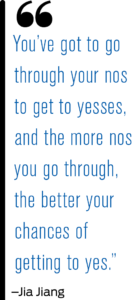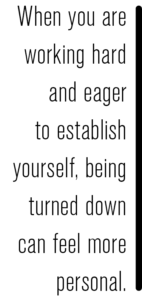2023 Sell-a-bration® speaker Jia Jiang is an expert on how to handle rejection and provides advice on how to overcome defeat
By Myrna Traylor
Real estate is a business based on forming (usually) one-on-one client relationships.
Thus, the probability of rejection is very high for real estate agents trying to build a customer base.
 It’s very likely that if you have been in this business for a while, you have faced your fair share of “no, thank yous.” But there are ways to deal with rejection that help take the sting out of a no and put you on the path to getting the next yes.
It’s very likely that if you have been in this business for a while, you have faced your fair share of “no, thank yous.” But there are ways to deal with rejection that help take the sting out of a no and put you on the path to getting the next yes.
Jia Jiang has become an expert on navigating rejection and offers guidance on the subject through public speaking engagements (he spoke at Sell-a-bration® in February 2023 in Atlanta, Georgia) and his website, rejectiontherapy.com. He offers good, relatable advice on the topic that can help you in your business and other pursuits.
It’s a numbers game
Jiang points out that it is a certainty that you will get some rejections. And, of course, you will also get some acceptances. “It really is a numbers game,” Jiang says. “You’ve got to go through your nos to get to yesses, and the more nos you go through, the better your chances of getting to yes.”
“Often people will internalize those nos and think ‘I’m not good enough,’ or ‘I didn’t present myself properly.’ By making the rejection about themselves instead of the situation, it causes them to lose confidence.” Jiang says that even if you aren’t providing that prospective client with a specific service they think they want, in the grand scheme of things, your success is not only about your abilities as an agent, “it’s more about stamina. It’s more about tenacity. Stamina and tenacity are skills you can develop.”
Why rejection stings
Like so many emotional responses, fear of rejection is wired into our brains. This is an outgrowth of humans’ development as a social species. “Think about our ancestors. They were able to survive because they were smart and they were great collaborators,” Jiang says. We weren’t as fast or as strong as other animals, and one could go very quickly from being the hunter to being the hunted. “In that type of environment, you cannot win by yourself, so rejection [from the group is a matter of] life and death. If you are ostracized, you cannot survive.”
Jiang says that our need for collaboration and acceptance has been so internalized that our brains cannot distinguish between physical and social pain. “Everyone hates rejection,” he says. “Some people are more tolerant of rejection than others, just as some tolerate physical pain better. These people have a strong advantage because they’re able to take those rejections and still persevere.”
Becoming proactive
Rejection can often feel different earlier in your career. When you are working hard and eager to establish yourself, being turned down can feel more personal. But Jiang reminds us that the rejection isn’t about you as a human being—even if it feels that way. Whether you are new in the real estate business, opening a new office or setting up shop in a new market, getting a no is an opportunity to assess how prepared you are for the customer base.
“When you get rejected by one client, it was their choice not to work with you,” he said. “But you have a choice, too. You can think that that is the end of the conversation with that person and move on, or you can fight back.” In the nicest way possible, of course.
Jiang explains that the choices we make in that moment of being turned down are key to building resilience—the stamina we’ll need to stay in the game. “If you’re very sensitive and just give up before you give yourself another shot, then you lose your chance,” he says. “But if you train yourself to be less afraid of rejection, you give yourself such an advantage in a competitive market.”
Practice makes perfect
One way to build up resilience, Jiang says, is to “go out and get rejected every day on purpose.” In his TED Talk, Jiang says that he built this technique by making requests with low-risk consequences. For example, he asked a Starbucks barista if he could act as a greeter in the café. “Instead of getting a yes as the success metric, make the ask the success metric.” This way, you are focusing on the part of the interaction over which you have control.
 For any request, Jiang says, there are two possible outcomes: yes and no. “You cannot control the outcome, but you can control the input—the ask. Making the ask is completely up to you and 100% in your control.” Here is how Jiang and other experts in sales describe how to make those requests properly and what to do when it doesn’t go your way:
For any request, Jiang says, there are two possible outcomes: yes and no. “You cannot control the outcome, but you can control the input—the ask. Making the ask is completely up to you and 100% in your control.” Here is how Jiang and other experts in sales describe how to make those requests properly and what to do when it doesn’t go your way:
Focus on your own intentions and actions. Don’t focus on the other person too much. Before you talk to your prospect, visualize how you would like to come across. You might even want to write out a script with important details related to what that customer will need from you.
Make eye contact and smile. You want to promote an air of confidence, so walk in with high positive energy.
Prepare your reaction to a no. Staying calm and asking the person why they didn’t accept your proposal can give you valuable feedback so you can improve your next performance.
Create more opportunities. Keep the pipeline of prospects as full as possible. Rejection is often a matter of timing; today’s no could be a yes tomorrow, so be prepared to circle back.
Even though you might never lose the fear of rejection completely, you can learn to circumvent the fear and lessen its importance and impact. “When you reduce the fear, your performance is a little bit different,” Jiang says. “You can make room for confidence, as well as curiosity and fun.”
Unlock more about Jia Jiang and his theory on rejection at rejectiontherapy.com.
Photo: iStock.com/shapecharge/Polina Tomtosova








